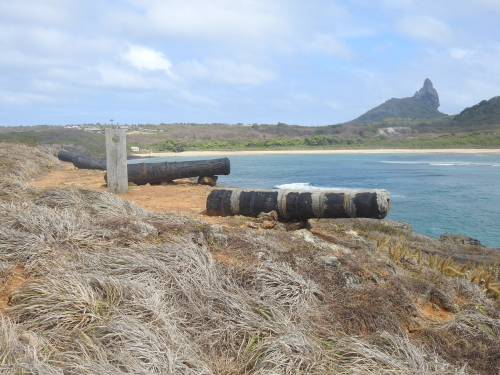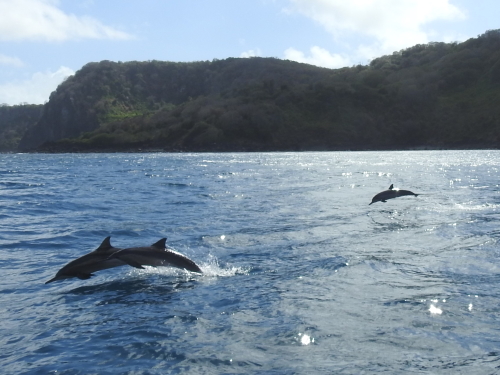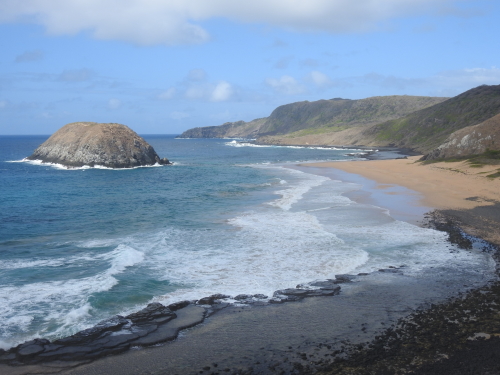Blog WHS Visits
WHS #813: Fernando de Noronha
Fernando de Noronha is one of the few islands in the South Atlantic – other notable ones are Gough Island, Tristan da Cunha, and St. Helena. That apparently makes it special enough to be considered a TCC ‘country’ and have its own Nomadmania region (though it is part of the state of Pernambuco), and about 70% of it is a WHS as well. Whether it is as good as Northern Atlantic ones such as the Azores, Cabo Verde, or even the Canary Islands, is questionable. It needed to team up with the more outstanding, more scenic, but inaccessible Rocas Atoll, 150 km away, to reach WH status. They are jointly known as the ‘Brazilian Atlantic Islands’.
I stayed on Fernando de Noronha for 3 nights and allotted a day to its marine features and two to its land surface. On the first afternoon, I walked from the town of Remedios to the northern tip of the island. A first beach, the remains of two Portuguese fortresses and offshore volcanic islands can be seen. At one of those islands, I spotted my first noteworthy bird: the masked booby.
The next morning I took a 3-hour boat tour along the western coast. We first circled the Secondary Islands, the same ones I saw yesterday from the shore. Visually the most attractive one is Cuscuz Island, shaped like a bowling ball. Black lava flows are a common sight as this archipelago is of volcanic origin. The phallic volcanic plug which is the highest peak of the island, Morro do Pico, is always drawing attention as well.
Exactly in the famous Baía dos Golfinhos (“the only known place in the world with such a high population of resident dolphins”), we encountered the spinner dolphins. They moved around quickly in pairs but showed themselves well by jumping fully out of the water. On the way back we had time to swim at Praia Sancho; I stayed on board, scanning the trees along the coast, and found many pairs of red-footed boobies. Colourful tropical fishes could even be seen well from the boat, the water is very clear.
On the third day, I did a 6km long DIY hike along the southern sights. I started at Praia de Leão, the prettiest of the beaches that I’ve seen on the island (photo 3). It has the obligatory peculiarly shaped rock in its bay and an impressive set of natural pools. Among the rocks, I noticed a rock cavy, a cute rodent but an invasive species. Nearby lies the Sao Joaquim Fort: 4 rusty canons remain (photo 1). From there good views of Sueste Bay can be had. This Bay has many special values, such as being the breeding place for turtles and having the only mangrove of the South Atlantic and the last patch of Insular Atlantic Rainforest. Except for the mangrove, however, these are not easily seen or distinguished.
On the morning before my return flight, I visited the Baia Golfinhos and Sancho Beach. These were the two that I earlier already had seen from the sea. Baia Golfinhos is where the spinner dolphins have breakfast. They drop by and feed here before swimming off into the ocean. The lookout is open from 6.30, this is as early as they will arrive. I arrived at 7.30 and still saw plenty of small pods visiting (about 40 individuals in an hour's time). The viewpoint is right above a resting and nesting place of red-footed boobies, so I got better photos of them too. From the Bay, there’s a 1200m long coastal trail to Sancho Beach, a very pleasant walk that brought a couple of lizards and more birds to my tally. Sancho Beach is the widest sandy beach on the island and the one most used for swimming.
Practicalities
Brazilians mainly seem to view it as a luxury beach retreat and foreigners don’t come here much. Still, if you keep in mind a few things, it is as easy as any other place in Brazil:
- Several daily flights connect it with Natal and Recife. They fly with small planes (50-70 seats). I paid 177 USD for the return trip.
- Expect costs of accommodation, food, and tours to be at least double of those in mainland Brazil.
- You have to pay a tax called TPA upon entering the island. The rates can be found here; they count per night (so 4-7 Dec was 3 days). It cannot be paid for beforehand online using a foreign credit card. Save the paper that you receive after paying at the airport, they will check it when you leave again.
- Furthermore, there is the park fee, which currently is R$ 358 for foreigners and is valid for 10 days. You can visit the northern parts of the park and therefore the core zone of the WHS without it, but for the better areas, you need to have one. You get a pretty credit card-type smart card, which is scanned at the turnstiles of the access points and before entering a boat. This can be paid for online, but you need to get to the ticket office or an access point (called PIC) to pick up the card.
- Tours can be easily arranged everywhere. A few trails to secluded beaches are only open to a limited number of visitors per day and/or need a guide. These are explained on the ICMBio website. You have to queue for those permits (following this process).
- There’s a handy municipal bus (R$ 5 flat fee) that crosses the island from north to south every half hour. It stops at all access points, towns, and the airport. As the island is only 17 square km, you can walk almost anywhere; there are good footpaths next to the main road.
- Mobile 4g is accessible reasonably well across the island, wifi (if present) usually is slow.
Els - 18 December 2022
Comments
Michael Ayers 18 December 2022
Good job.... Glad you made it!


